Shoreline Response to Hurricane Otis and Flooding Impact from Hurricane John in Acapulco, Mexico
Abstract
1. Introduction
2. Materials and Methods
2.1. Study Area
2.2. Environmental Data
2.3. Shoreline Monitoring
2.4. Synthetic Aperture Radar Analysis
3. Results
4. Discussion
5. Conclusions
Author Contributions
Funding
Data Availability Statement
Acknowledgments
Conflicts of Interest
References
- Lugo, A.E. Visible and Invisible Effects of Hurricanes on Forest Ecosystems: An International Review. Austral Ecol. 2008, 33, 368–398. [Google Scholar] [CrossRef]
- Ameca, E.I.; Nie, Y.; Wu, R.; Mittermeier, R.A.; Foden, W.; Wei, F. Identifying Protected Areas in Biodiversity Hotspots at Risk from Climate and Human-Induced Compound Events for Conserving Threatened Species. Sci. Total Environ. 2024, 938, 173192. [Google Scholar] [CrossRef] [PubMed]
- Jáuregui, E. Climatology of Landfalling Hurricanes and Tropical Storms in Mexico. Atmosfera 2003, 16, 193–204. [Google Scholar]
- Chen, Q.; Wang, L.; Tawes, R. Hydrodynamic Response of Northeastern Gulf of Mexico to Hurricanes. Estuaries Coasts 2008, 31, 1098–1116. [Google Scholar] [CrossRef]
- Hook, D.D.; Buford, M.A.; Williams, T.M. Impact of Hurricane Hugo on the South Carolina Coastal Plain Forest. J. Coast. Res. Spec. Issue 1992, 8, 291–300. [Google Scholar]
- Stanturf, J.A.; Goodrick, S.L.; Outcalt, K.W. Disturbance and Coastal Forests: A Strategic Approach to Forest Management in Hurricane Impact Zones. Ecol. Manag. 2007, 250, 119–135. [Google Scholar] [CrossRef]
- Wang, X.; Wang, W.; Tong, C. A Review on Impact of Typhoons and Hurricanes on Coastal Wetland Ecosystems. Shengtai Xuebao 2016, 36, 23–29. [Google Scholar] [CrossRef]
- Huang, A.; Medeiros, M. How Do Hurricanes Impact the Tourism Economy? Anatolia 2021, 32, 513–516. [Google Scholar] [CrossRef]
- Hernández, M.L.; Carreño, M.L.; Castillo, L. Methodologies and Tools of Risk Management: Hurricane Risk Index (HRi). Int. J. Disaster Risk Reduct. 2018, 31, 926–937. [Google Scholar] [CrossRef]
- Klemas, V. Beach Profiling and LIDAR Bathymetry: An Overview with Case Studies. J. Coast. Res. 2011, 27, 1019–1028. [Google Scholar] [CrossRef]
- Flores-de-Santiago, F.; Valderrama-Landeros, L.; Villaseñor-Aguirre, J.; Álvarez-Sánchez, L.F.; Rodríguez-Sobreyra, R.; Flores-Verdugo, F. Detection of Beach–Dune Geomorphic Changes by Means of Satellite and Unmanned Aerial Vehicle Data: The Case of Altamura Island in the Gulf of California. Coasts 2023, 3, 383–400. [Google Scholar] [CrossRef]
- Besset, M.; Anthony, E.J.; Bouchette, F. Multi-Decadal Variations in Delta Shorelines and Their Relationship to River Sediment Supply: An Assessment and Review. Earth Sci. Rev. 2019, 193, 199–219. [Google Scholar] [CrossRef]
- Rodrigues Nunes, J.C.; Puhl, E.; Aliotta, S.; Toldo, E.E.; Machado Schffer, P.N.; Fick, C.; Lima-Filho, F.P.; Andrade dos Reis Junior, J.; Silveira dos Santos, G.; Barros, C.A.; et al. Beach Ridge Sequence Evolution of Punta Verde, Northern Coast of the San Matías Gulf, Argentina. J. S. Am. Earth Sci. 2024, 133, 104704. [Google Scholar] [CrossRef]
- Toimil, A.; Camus, P.; Losada, I.J.; Le Cozannet, G.; Nicholls, R.J.; Idier, D.; Maspataud, A. Climate Change-Driven Coastal Erosion Modelling in Temperate Sandy Beaches: Methods and Uncertainty Treatment. Earth Sci. Rev. 2020, 202, 103110. [Google Scholar] [CrossRef]
- Brand, E.; Chen, M.; Montreuil, A.L. Optimizing Measurements of Sediment Transport in the Intertidal Zone. Earth Sci. Rev. 2020, 200, 103029. [Google Scholar] [CrossRef]
- Okyay, U.; Telling, J.; Glennie, C.L.; Dietrich, W.E. Airborne Lidar Change Detection: An Overview of Earth Sciences Applications. Earth Sci. Rev. 2019, 198, 102929. [Google Scholar] [CrossRef]
- Greer, J.M. A Sampling of Environmental Data, and Its Presentation, from a Multi-Role U.S. Coast Guard Aircraft. Corros. Rev. 2023, 41, 103–113. [Google Scholar] [CrossRef]
- Villalobos Perna, P.; Di Febbraro, M.; Carranza, M.L.; Marzialetti, F.; Innangi, M. Remote Sensing and Invasive Plants in Coastal Ecosystems: What We Know So Far and Future Prospects. Land 2023, 12, 341. [Google Scholar] [CrossRef]
- Dronova, I.; Kislik, C.; Dinh, Z.; Kelly, M. A Review of Unoccupied Aerial Vehicle Use in Wetland Applications: Emerging Opportunities in Approach, Technology, and Data. Drones 2021, 5, 45. [Google Scholar] [CrossRef]
- Adade, R.; Aibinu, A.M.; Ekumah, B.; Asaana, J. Unmanned Aerial Vehicle (UAV) Applications in Coastal Zone Management—A Review. Environ. Monit. Assess. 2021, 193, 154. [Google Scholar] [CrossRef] [PubMed]
- Alvarez-Vanhard, E.; Houet, T.; Mony, C.; Lecoq, L.; Corpetti, T. Can UAVs Fill the Gap Between in Situ Surveys and Satellites for Habitat Mapping? Remote Sens. Environ. 2020, 243, 111780. [Google Scholar] [CrossRef]
- Kumar, P.; Debele, S.E.; Sahani, J.; Rawat, N.; Marti-Cardona, B.; Alfieri, S.M.; Basu, B.; Basu, A.S.; Bowyer, P.; Charizopoulos, N.; et al. An Overview of Monitoring Methods for Assessing the Performance of Nature-Based Solutions against Natural Hazards. Earth Sci. Rev. 2021, 217, 103603. [Google Scholar] [CrossRef]
- Mondal, M.; Mukherjee, A.; Kumar, P.; Ismaeel, N.M.; Das, K. A Process-Based Impact of Tropical Cyclone and Hurricane on Surface Water-Groundwater Interaction and Contaminant Mobilization of Coastal Aquifers. Prog. Disaster Sci. 2024, 22, 100318. [Google Scholar] [CrossRef]
- Yim, W.W.-S. Hurricanes and Typhoons: Past, Present, and Future. Eos. Trans. Am. Geophys. Union 2005, 86, 166. [Google Scholar] [CrossRef]
- Vizcaya-Martínez, D.A.; Flores-de-Santiago, F.; Valderrama-Landeros, L.; Serrano, D.; Rodríguez-Sobreyra, R.; Álvarez-Sánchez, L.F.; Flores-Verdugo, F. Monitoring Detailed Mangrove Hurricane Damage and Early Recovery Using Multisource Remote Sensing Data. J. Environ. Manag. 2022, 320, 115830. [Google Scholar] [CrossRef] [PubMed]
- McCarthy, M.J.; Jessen, B.; Barry, M.J.; Figueroa, M.; McIntosh, J.; Murray, T.; Schmid, J.; Muller-Karger, F.E. Mapping Hurricane Damage: A Comparative Analysis of Satellite Monitoring Methods. Int. J. Appl. Earth Obs. Geoinf. 2020, 91, 102134. [Google Scholar] [CrossRef]
- Sunkur, R.; Kantamaneni, K.; Bokhoree, C.; Rathnayake, U.; Fernando, M. Mangrove Mapping and Monitoring Using Remote Sensing Techniques towards Climate Change Resilience. Sci. Rep. 2024, 14, 6949. [Google Scholar] [CrossRef]
- Mouche, A.; Chapron, B.; Knaff, J.; Zhao, Y.; Zhang, B.; Combot, C. Copolarized and Cross-Polarized SAR Measurements for High-Resolution Description of Major Hurricane Wind Structures: Application to Irma Category 5 Hurricane. J. Geophys. Res. Ocean. 2019, 124, 3905–3922. [Google Scholar] [CrossRef]
- Kovacs, J.M.; De Santiago, F.F.; Bastien, J.; Lafrance, P. An Assessment of Mangroves in Guinea, West Africa, Using a Field and Remote Sensing Based Approach. Wetlands 2010, 30, 773–782. [Google Scholar] [CrossRef]
- Miranda-Esteban, A.; Bedolla-Solano, R.; Bedolla-Solano, I. The Impact of Hurricane Otis on the Student Community of the School of Sociology, Mexico. Int. Soc. Study Vernac. Settl. 2023, 10, 729–751. [Google Scholar] [CrossRef]
- Urrutia-Fucugauchi, J.; Fernández-Martínez, I.; Lara-Omaña, A.; Rosales-Armendariz, C.; Cavazos, T.; Pérez-Cruz, L.; Zapotitla-Roman, J. LiDAR and Photogrammetric Study of the Acapulco Bay after the October 2023 Otis Hurricane in Southern Mexico. Nat. Hazards. 2025, 121, 1–18. [Google Scholar] [CrossRef]
- Carvache-Franco, M.; Carvache-Franco, W.; Carvache-Franco, O.; Solis-Radilla, M.M.; Morrison, M.; Pulido-Fernández, J.I. Tourism Market Segmentation Applied to Coastal and Marine Destinations: A Study from Acapulco, Mexico. Sustainability 2021, 13, 13903. [Google Scholar] [CrossRef]
- Rodriguez, A. Las Inundaciones En Llano Largo, Acapulco: Riesgo, Turismo y Desarrollo. In Las inundaciones en Llano Largo, Acapulco: Riesgo, Turismo y Desarrollo; Plaza y Valdés, SA de CV: Ciudad de México, Mexico, 2011. [Google Scholar]
- Roy, P.D.; Natarajan, L.; Chokkalingam, L. Changes in Lu/Lc and Vegetation around the Acapulco Bay at Southwest Mexico from the Hurricane Otis (October 25, 2023). J. S. Am. Earth Sci. 2024, 136, 104819. [Google Scholar] [CrossRef]
- Niño-Gutiérrez, N.S. Resilience in Adversity: Acapulco and the Aftermath of Otis Hurricane Category 5 of October 25, 2023. South Asian J. Soc. Stud. Econ. 2023, 20, 209–224. [Google Scholar] [CrossRef]
- Gao, B.C. NDWI—A Normalized Difference Water Index for Remote Sensing of Vegetation Liquid Water from Space. Remote Sens. Environ. 1996, 58, 257–266. [Google Scholar] [CrossRef]
- Roy, D.P.; Huang, H.; Houborg, R.; Martins, V.S. A Global Analysis of the Temporal Availability of PlanetScope High Spatial Resolution Multi-Spectral Imagery. Remote Sens. Environ. 2021, 264, 112586. [Google Scholar] [CrossRef]
- Valderrama-Landeros, L.; Flores-de-Santiago, F.; Álvarez-Sánchez, L.F.; Flores-Verdugo, F.; Rodríguez-Sobreyra, R. The Influence of Spatial Resolution on Coastline Detection by Means of Multisource Remote Sensing Data. Remote Sens. Appl. 2024, 35, 101258. [Google Scholar] [CrossRef]
- Valderrama-Landeros, L.; Flores-de-Santiago, F. Assessing Coastal Erosion and Accretion Trends along Two Contrasting Subtropical Rivers Based on Remote Sensing Data. Ocean. Coast. Manag. 2019, 169, 58–67. [Google Scholar] [CrossRef]
- Valderrama-Landeros, L.; Flores-Verdugo, F.; Flores-de-Santiago, F. Assessing the Coastal Vulnerability by Combining Field Surveys and the Analytical Potential of CoastSat in a Highly Impacted Tourist Destination. Geographies 2022, 2, 642–656. [Google Scholar] [CrossRef]
- Huang, K.; Yang, G.; Yuan, Y.; Sun, W.; Meng, X.; Ge, Y. Optical and SAR Images Combined Mangrove Index Based on Multi-Feature Fusion. Sci. Remote Sens. 2022, 5, 100040. [Google Scholar] [CrossRef]
- Crippen, R.; Buckley, S.; Agram, P.; Belz, E.; Gurrola, E.; Hensley, S.; Kobrick, M.; Lavalle, M.; Martin, J.; Neumann, M.; et al. Nasadem global elevation model: Methods and progress. Int. Arch. Photogramm. Remote Sens. Spat. Inf. Sci. 2016, 41, 125–128. [Google Scholar] [CrossRef]
- Brown, C.F.; Brumby, S.P.; Guzder-Williams, B.; Birch, T.; Hyde, S.B.; Mazzariello, J.; Czerwinski, W.; Pasquarella, V.J.; Haertel, R.; Ilyushchenko, S.; et al. Dynamic World, Near Real-Time Global 10 m Land Use Land Cover Mapping. Sci. Data 2022, 9, 251. [Google Scholar] [CrossRef]
- Ahmad, S.K.; Hossain, F.; Eldardiry, H.; Pavelsky, T.M. A Fusion Approach for Water Area Classification Using Visible, near Infrared and Synthetic Aperture Radar for South Asian Conditions. IEEE Trans. Geosci. Remote Sens. 2020, 58, 2471–2480. [Google Scholar] [CrossRef]
- Kovacs, J.M.; Lu, X.X.; Flores-Verdugo, F.; Zhang, C.; Flores de Santiago, F.; Jiao, X. Applications of ALOS PALSAR for Monitoring Biophysical Parameters of a Degraded Black Mangrove (Avicennia Germinans) Forest. ISPRS J. Photogramm. Remote Sens. 2013, 82, 102–111. [Google Scholar] [CrossRef]
- Flores-de-Santiago, F.; Kovacs, J.M.; Lafrance, P. An Object-Oriented Classification Method for Mapping Mangroves in Guinea, West Africa, Using Multipolarized ALOS PALSAR L-Band Data. Int. J. Remote Sens. 2013, 34, 563–586. [Google Scholar] [CrossRef]
- Montgomery, J.S.; Hopkinson, C.; Brisco, B.; Patterson, S.; Rood, S.B. Wetland Hydroperiod Classification in the Western Prairies Using Multitemporal Synthetic Aperture Radar. Hydrol. Process. 2018, 32, 1476–1490. [Google Scholar] [CrossRef]
- Mullissa, A.; Vollrath, A.; Odongo-Braun, C.; Slagter, B.; Balling, J.; Gou, Y.; Gorelick, N.; Reiche, J. Sentinel-1 Sar Backscatter Analysis Ready Data Preparation in Google Earth Engine. Remote Sens. 2021, 13, 1954. [Google Scholar] [CrossRef]
- Hersbach, H. The ERA5 Atmospheric Reanalysis. In Proceedings of the AGU fall meeting abstracts, San Francisco, CA, USA, 12–16 December 2016; Volume 2016. [Google Scholar]
- Potisomporn, P.; Adcock, T.A.A.; Vogel, C.R. Evaluating ERA5 Reanalysis Predictions of Low Wind Speed Events around the UK. Energy Rep. 2023, 10, 4781–4790. [Google Scholar] [CrossRef]
- Davidson, M.R.; Millstein, D. Limitations of Reanalysis Data for Wind Power Applications. Wind Energy 2022, 25, 1646–1653. [Google Scholar] [CrossRef]
- Valderrama-Landeros, L.; Blanco y Correa, M.; Flores-Verdugo, F.; Álvarez-Sánchez, L.F.; Flores-de-Santiago, F. Spatiotemporal Shoreline Dynamics of Marismas Nacionales, Pacific Coast of Mexico, Based on a Remote Sensing and GIS Mapping Approach. Env. Monit. Assess. 2020, 192, 123. [Google Scholar] [CrossRef] [PubMed]
- Ramesh, M.; Swathy Krishna, P.S.; Amrutha Raj, V.; Sheela Nair, L. Coupled Coastal Monitoring Framework for the Analysis of Beach Stability and Nearshore Hydrodynamics of a Structure Influenced Medium Energy Coast in India. Ocean. Coast. Manag. 2023, 239, 106619. [Google Scholar] [CrossRef]
- Billet, C.; Alonso, G.; Danieli, G.; Dragani, W. Evaluation of Beach Nourishment in Mar Del Plata, Argentina: An Application of the CoastSat Toolkit. Coast. Eng. 2024, 193, 104593. [Google Scholar] [CrossRef]
- Komar, P.D. Coastal Erosion Processes and Impacts: The Consequences of Earth’s Changing Climate and Human Modifications of the Environment. In Treatise on Estuarine and Coastal Science; Academic Press: San Diego, CA, USA, 2012; Volume 3. [Google Scholar]
- Ngowo, R.G.; Ribeiro, M.C.; Pereira, M.J. Quantifying 28-Year (1991–2019) Shoreline Change Trends along the Mnazi Bay—Ruvuma Estuary Marine Park, Tanzania. Remote Sens. Appl. 2021, 23, 100607. [Google Scholar] [CrossRef]
- Ramírez-Herrera, M.T.; Coca, O.; Gaidzik, K.; Vargas Espinosa, V.H. Hurricane Otis: Category 5 Storm Effects and Cascading Hazards in Acapulco Bay, Mexico. Glob. Earth Surf. Process. Change 2025, 3, 100004. [Google Scholar] [CrossRef]
- Blanco Betancourt, R.; Gómez Reyes, E.; Mascarenhas, A.D.S. Subtidal Water Exchange between Caimanero Lagoon and the Adjacent Inner Shelf, West Coast of México: Seasonal Circulation Pattern and Its Implication. J. Coast. Res. 2008, 24, 83–94. [Google Scholar] [CrossRef]
- Thinh, N.A.; Thanh, N.N.; Tuyen, L.T.; Hens, L. Tourism and Beach Erosion: Valuing the Damage of Beach Erosion for Tourism in the Hoi An World Heritage Site, Vietnam. Environ. Dev. Sustain. 2019, 21, 2113–2124. [Google Scholar] [CrossRef]
- Hernández-Guzmán, R.; Ruiz-Luna, A.; Cervantes-Escobar, A. Environmental Flow Assessment for Rivers Feeding a Coastal Wetland Complex in the Pacific Coast of Northwest Mexico. Water Environ. J. 2019, 33, 536–546. [Google Scholar] [CrossRef]
- Flores-de-Santiago, F.; Rodríguez-Sobreyra, R.; Álvarez-Sánchez, L.F.; Valderrama-Landeros, L.; Amezcua, F.; Flores-Verdugo, F. Understanding the Natural Expansion of White Mangrove (Laguncularia Racemosa) in an Ephemeral Inlet Based on Geomorphological Analysis and Remote Sensing Data. J. Environ. Manag. 2023, 338, 117820. [Google Scholar] [CrossRef]
- Zhang, C.; Xiao, X.; Zhao, L.; Qin, Y.; Doughty, R.; Wang, X.; Dong, J.; Yang, X. Mapping Eucalyptus Plantation in Guangxi, China by Using Knowledge-Based Algorithms and PALSAR-2, Sentinel-2, and Landsat Images in 2020. Int. J. Appl. Earth Obs. Geoinf. 2023, 120, 103348. [Google Scholar] [CrossRef]
- Colin, A.; Tandeo, P.; Peureux, C.; Husson, R.; Longepe, N.; Fablet, R. Rain Regime Segmentation of Sentinel-1 Observation Learning from NEXRAD Collocations with Convolution Neural Networks. IEEE Trans. Geosci. Remote Sens. 2024, 62, 4202914. [Google Scholar] [CrossRef]
- Adeli, S.; Salehi, B.; Mahdianpari, M.; Quackenbush, L.J.; Brisco, B.; Tamiminia, H.; Shaw, S. Wetland Monitoring Using SAR Data: A Meta-Analysis and Comprehensive Review. Remote Sens. 2020, 12, 2190. [Google Scholar] [CrossRef]
- Zhao, Y.; Longépé, N.; Mouche, A.; Husson, R. Automated Rain Detection by Dual-Polarization Sentinel-1 Data. Remote Sens. 2021, 13, 3155. [Google Scholar] [CrossRef]
- Zhao, X.; Shao, W.; Lai, Z.; Jiang, X. Retrieval of Rain Rates for Tropical Cyclones from Sentinel-1 Synthetic Aperture Radar Images. IEEE J. Sel. Top. Appl. Earth Obs. Remote Sens. 2023, 16, 3187–3197. [Google Scholar] [CrossRef]
- Knight, J. The Green Infrastructure of Sandy Coastlines: A Nature-Based Solution for Mitigation of Climate Change Risks. Sustainability 2024, 16, 1056. [Google Scholar] [CrossRef]
- Hofstede, J.L.A. Status and Prospects of Nature-Based Solutions for Coastal Flood and Erosion Risk Management in the Federal State of Schleswig–Holstein, Germany. J. Coast. Conserv. 2024, 28, 40. [Google Scholar] [CrossRef]
- Soanes, L.M.; Pike, S.; Barker, D.; Butt, C.; John, L.; Medcalf, K.; Naumann, E.; Rouse, C.; Samuel, C.A.; Mukhida, F. Opportunity Mapping for Nature-Based Solutions: Mitigating Storm Surge and Land Erosion in the Caribbean. Nat.-Based Solut. 2023, 4, 100095. [Google Scholar] [CrossRef]
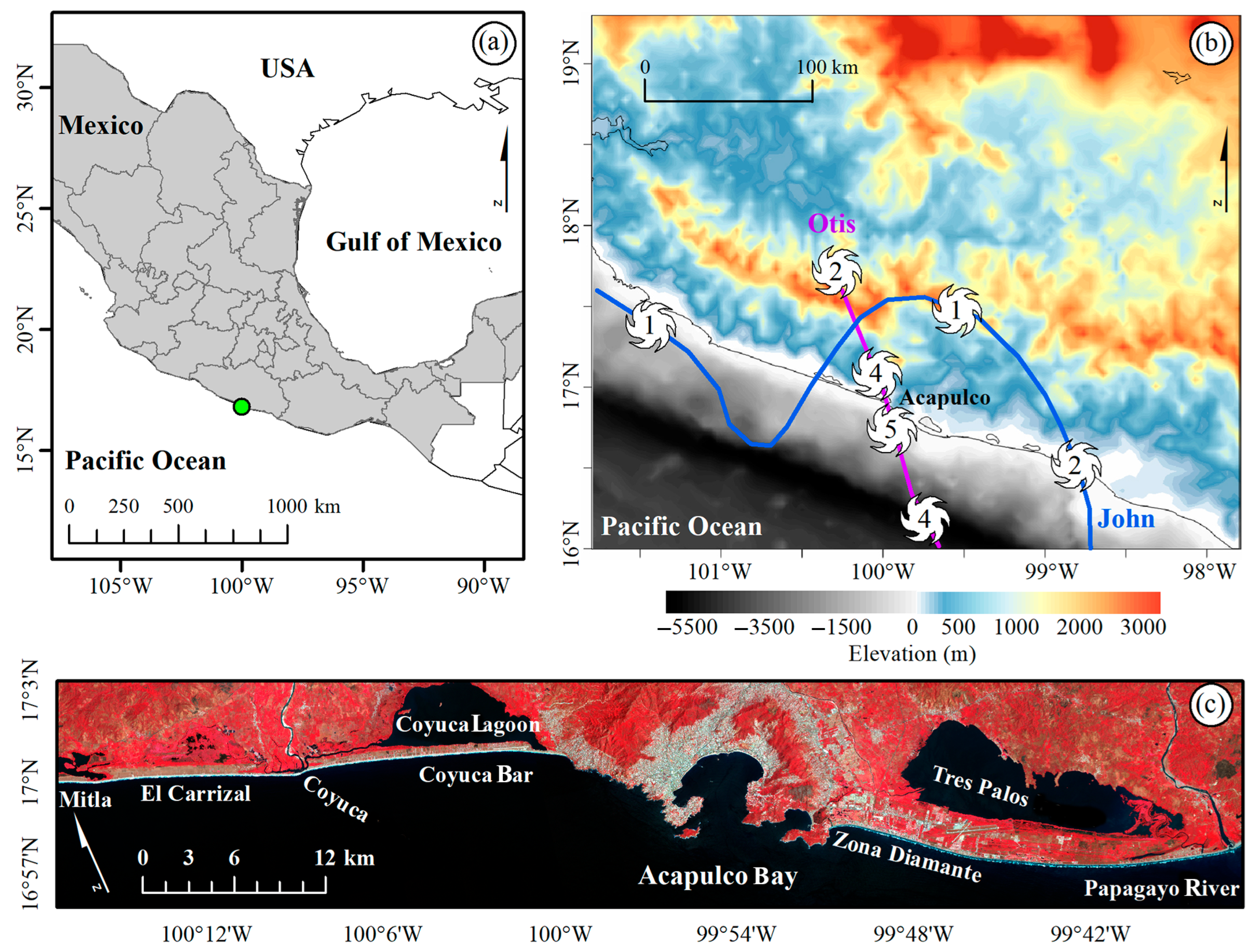
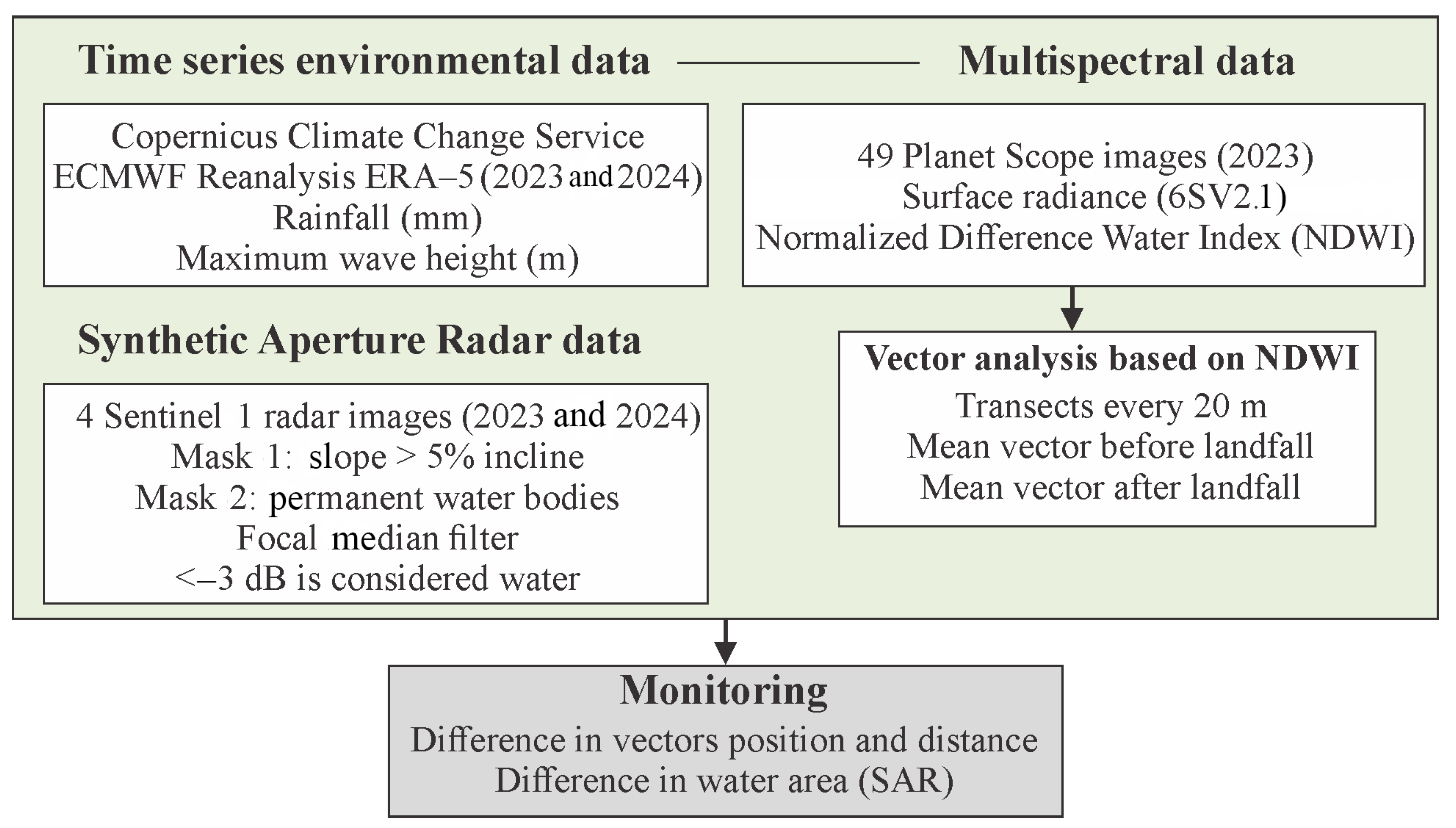
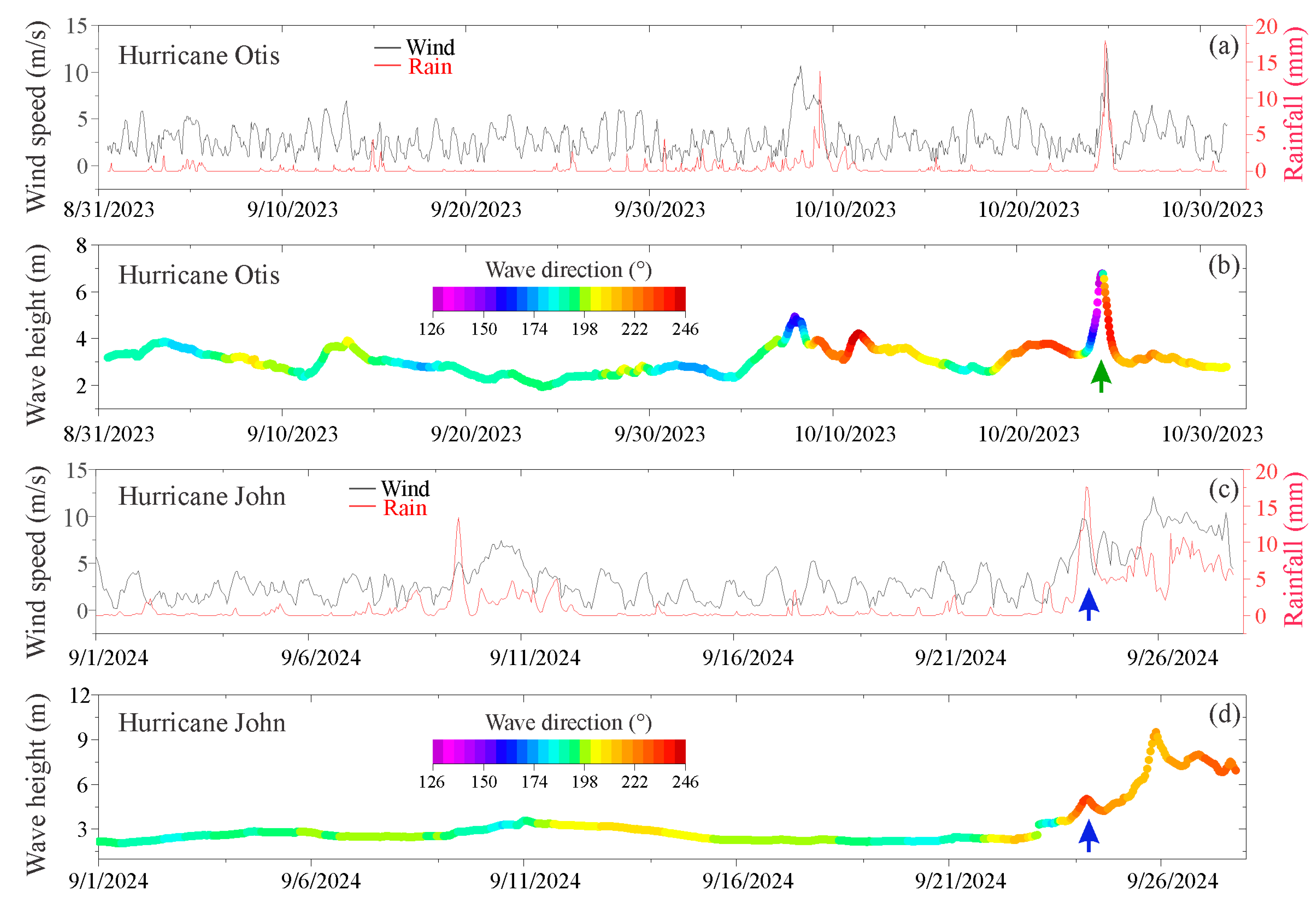
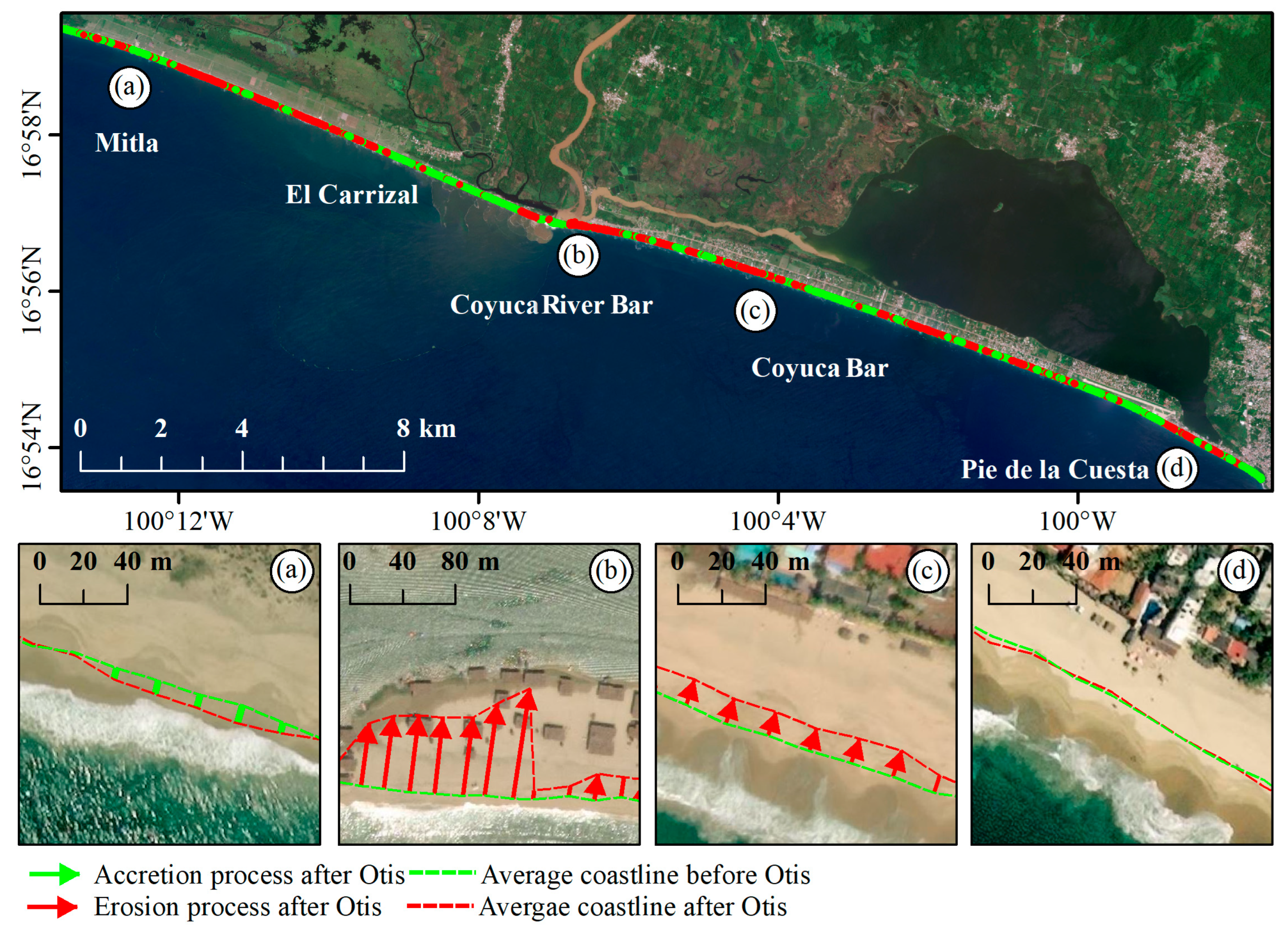
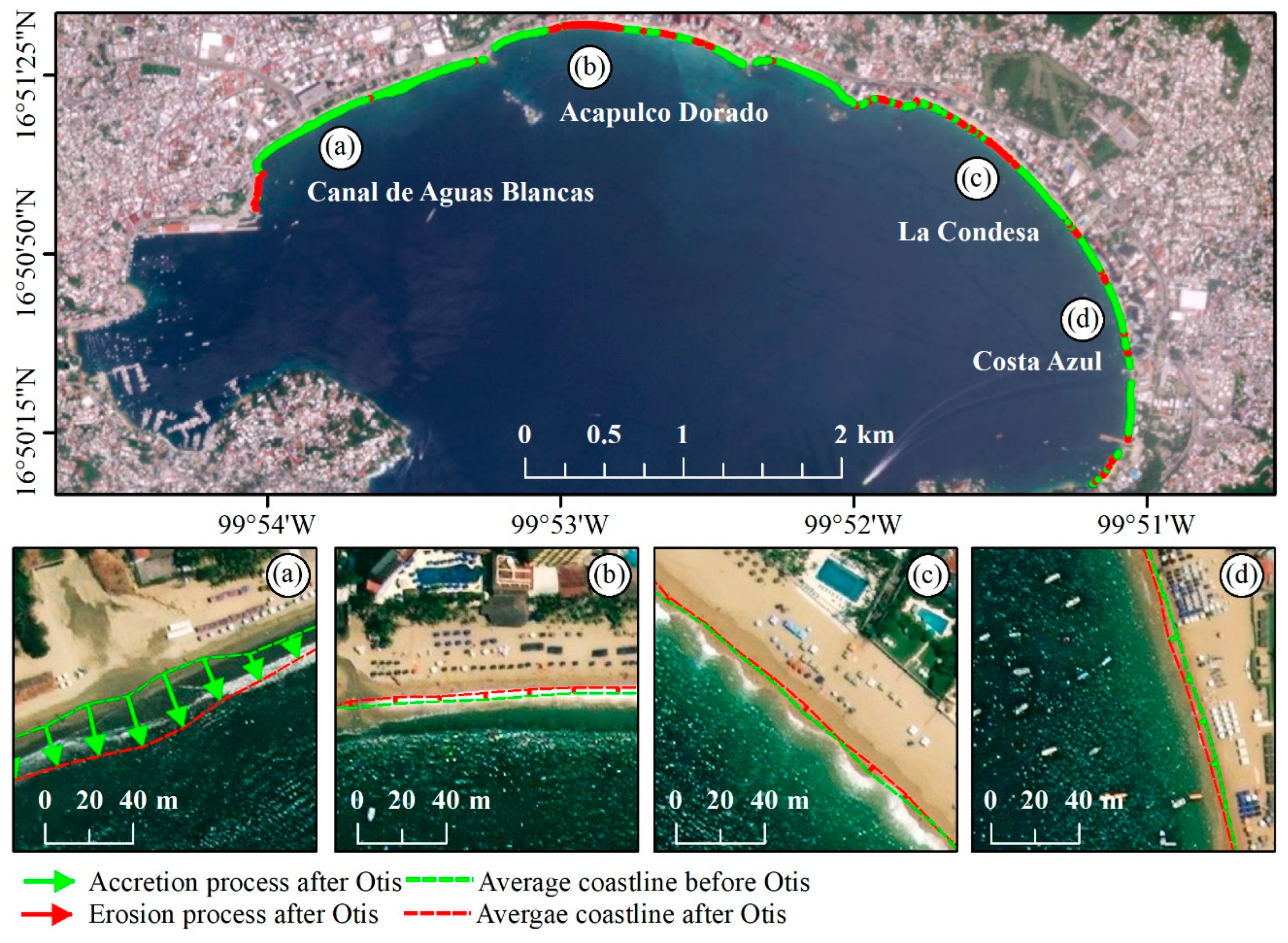

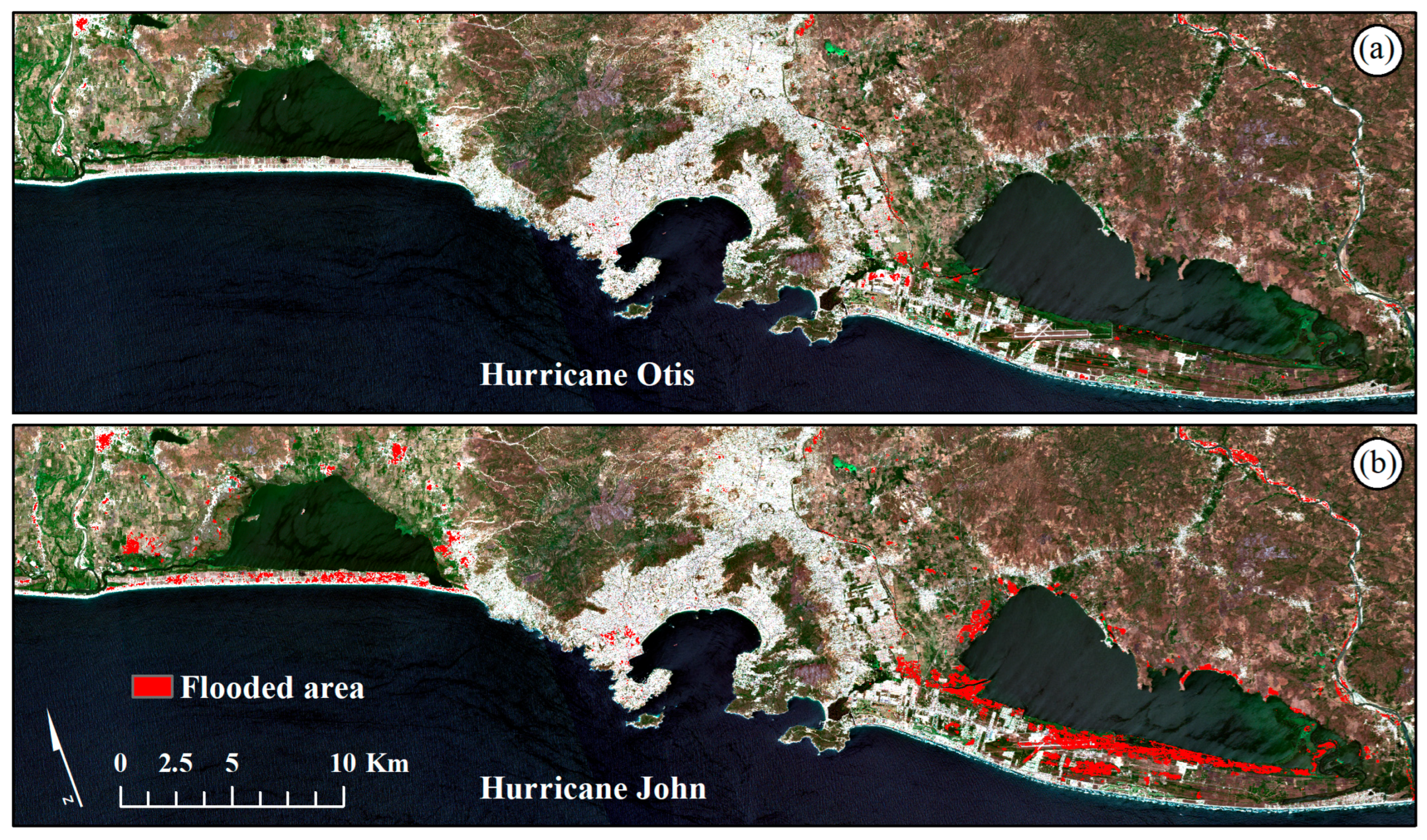
Disclaimer/Publisher’s Note: The statements, opinions and data contained in all publications are solely those of the individual author(s) and contributor(s) and not of MDPI and/or the editor(s). MDPI and/or the editor(s) disclaim responsibility for any injury to people or property resulting from any ideas, methods, instructions or products referred to in the content. |
© 2025 by the authors. Licensee MDPI, Basel, Switzerland. This article is an open access article distributed under the terms and conditions of the Creative Commons Attribution (CC BY) license (https://creativecommons.org/licenses/by/4.0/).
Share and Cite
Valderrama-Landeros, L.; Pérez-Espinosa, I.; Villeda-Chávez, E.; Alarcón-Medina, R.; Flores-de-Santiago, F. Shoreline Response to Hurricane Otis and Flooding Impact from Hurricane John in Acapulco, Mexico. Coasts 2025, 5, 28. https://doi.org/10.3390/coasts5030028
Valderrama-Landeros L, Pérez-Espinosa I, Villeda-Chávez E, Alarcón-Medina R, Flores-de-Santiago F. Shoreline Response to Hurricane Otis and Flooding Impact from Hurricane John in Acapulco, Mexico. Coasts. 2025; 5(3):28. https://doi.org/10.3390/coasts5030028
Chicago/Turabian StyleValderrama-Landeros, Luis, Iliana Pérez-Espinosa, Edgar Villeda-Chávez, Rafael Alarcón-Medina, and Francisco Flores-de-Santiago. 2025. "Shoreline Response to Hurricane Otis and Flooding Impact from Hurricane John in Acapulco, Mexico" Coasts 5, no. 3: 28. https://doi.org/10.3390/coasts5030028
APA StyleValderrama-Landeros, L., Pérez-Espinosa, I., Villeda-Chávez, E., Alarcón-Medina, R., & Flores-de-Santiago, F. (2025). Shoreline Response to Hurricane Otis and Flooding Impact from Hurricane John in Acapulco, Mexico. Coasts, 5(3), 28. https://doi.org/10.3390/coasts5030028







